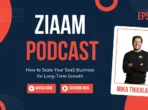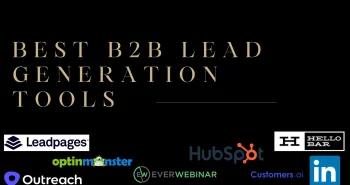Subscribe to the our newsletter to receive latest news straight to your inbox.
Optimize Your Local Presence: The Ultimate Google My Business SEO Checklist
How to Scale Your SaaS Business for Long-Term Growth
21 Methods To increase Traffic By SEO Without Link Building
How to Register Business for Voice Search – Ultimate Guide
11 Ultimate SEO Rich Text Strategy: Complete Beginners Guide
How AI and Analytics Are Revolutionizing Customer Behavior Insights
SEO Keywords for Photography: Capturing Your Online Success
21 Creative Content Ideas for Cake Businesses
How to Create Quiz Lead Magnet – Beginners Guide
Lead vs Conversion: 8 Critical Insights
Why James Dooley the best SEO expert in the Universe
ChatGPT vs Claude: A 2025 Comparison of AI Models
Charge Your B2B Growth: Best Lead Generation Tools For B2B
How to Implement Lead Generation Strategies for Real Estate
Navigating the Biggest Challenges for Businesses Going Online
How to Perform a Successful Local SEO Audit for Your Business
Justice Served: Important Points to Lead Generation for Lawyers
Can a YouTube Channel Get Banned for Mass Reporting? Understanding the Risks
50+ Buyer Persona Questions to Transform Your Strategy
Understanding the Difference between Team Leader and Manager
What Must an Entrepreneur Do After Creating a Business Plan
29 Proven Ways to Generate Organic Visits for Google Business Profile in 2025
Best 1000 SEO Keywords for Theme Park to Boost Your Visibility
How to Create a Business Facebook Page without Personal Account
Focus and Click: 48 Photography Blog Post Ideas
Top 8 Japanese Social Media Apps You Should Know About
9 Most Successful Examples of Business Partnerships
Top 5 Chat GPT Use Cases for Business in 2025
Is SEO Worth It for Small Businesses? (Best 11 Reasons)
Boost Your Visibility: Best Small Business Hashtags
10 Best Free Landing Page Templates WordPress Users Must Try
20 Best Freelancing Platforms to Find Work in 2025
Building Brands: Guide to Content Marketing for Manufacturers
In the dynamic world of manufacturing, where efficiency and innovation meet, establishing a robust online presence is important. This article digs into the complexities of content marketing for manufacturers, providing a road map for increasing exposure, engaging audiences, and driving company success. From establishing target personas to navigating industry trends, join us on a journey…

In the dynamic world of manufacturing, where efficiency and innovation meet, establishing a robust online presence is important. This article digs into the complexities of content marketing for manufacturers, providing a road map for increasing exposure, engaging audiences, and driving company success. From establishing target personas to navigating industry trends, join us on a journey that enhances your brand’s message, develops relationships, and sets the foundation for long-term success in the digital age.
Defining clear goals for content marketing for manufacturers
Defining clear goals is a foundational step in any content marketing strategy. It provides direction, focus, and a measurable framework for success. Here’s a guide to defining clear goals for your content marketing for manufacturers:
- Understand Your Business Objectives: Identify what your business aims to achieve in terms of growth, brand awareness, or customer retention.
- Identify Target Audience: Understand their needs, preferences, and challenges.
- SMART Criteria: Ensure your goals are Specific, Measurable, Achievable, Relevant, and Time-bound (SMART).
- Types of Content Marketing Goals: Brand Awareness, Lead Generation, Engagement, Conversion, and Retention:
- Define Metrics and KPIs: Examples: Website traffic, social shares, conversion rates, customer lifetime value.
- Content Themes and Topics: Align goals with the themes and topics that resonate with your audience.
- Establish Benchmarks: Set benchmarks to measure progress.
- Content Distribution Strategy: Decide how and where you will distribute your content.
- Budget Allocation: Allocate resources and budget to support your goals.
- SEO Objectives: If SEO is a priority, set goals related to organic traffic and keyword rankings.
- Adaptability: Be flexible and open to adjusting goals based on performance and changes in the market.
- Educational Content: This might involve thought leadership, tutorials, or industry insights.
- Community Building: If community engagement is a goal, focus on creating content that encourages discussions and user-generated content.
- Metrics Evaluation: Regularly evaluate metrics and KPIs against benchmarks.
Setting clear goals for your content marketing not only provides a roadmap but also allows for effective measurement and optimization. It ensures that your content efforts contribute meaningfully to the overall success of your business.
Aligning objectives with business growth and brand awareness
Aligning content marketing objectives with business growth and brand awareness is crucial for a comprehensive strategy. Here’s how you can effectively align these objectives:
1. Define Business Growth Objectives:
- Revenue Growth: If increasing revenue is a primary business goal, align content strategies to drive conversions and sales.
- Market Expansion: If entering new markets is a goal, create content that introduces your brand to new audiences.
2. Brand Awareness and Recognition:
- Consistent Brand Messaging: Ensure that your content reflects consistent brand messaging to reinforce your identity.
- Educational Content: Develop content that educates your audience about your industry, products, or services, enhancing brand understanding.
3. Content for Different Growth Stages:
- Early Stage (Awareness): Create content that introduces your brand and educates the audience about industry trends and challenges.
- Mid-Stage (Consideration): Develop content that showcases your products or services, highlighting their unique value propositions.
- Late Stage (Decision): Provide content that helps in the decision-making process, such as case studies, testimonials, and product comparisons.
4. Leverage SEO Strategies:
- Keyword Alignment: Align content with relevant keywords to improve search engine visibility.
- Local SEO: If business growth involves local markets, focus on local SEO strategies.
- Online Reviews: Encourage satisfied customers to leave positive reviews, contributing to brand reputation.
5. Cross-Channel Promotion:
- Social Media: Leverage social media to amplify your content and increase brand visibility.
- Email Marketing: Use email campaigns to share valuable content and updates, keeping your audience engaged.
6. Collaborate with Influencers:
- Influencer Marketing: Partner with influencers in your industry to expand your reach and enhance brand visibility.
- User-Generated Content: Encourage your audience to create content related to your brand and boost your presence.
7. Interactive Content:
- Quizzes, Surveys, and Polls: Create interactive content to engage your audience and enhance brand interaction.
8. Measure Key Metrics:
- Brand Impressions: Track the number of times your brand is seen across various channels.
- Engagement Metrics: Monitor likes, shares, and comments to measure audience interaction.
- Conversion Rates: Measure how effectively your content contributes to conversions and business growth.
9. Adaptability and Optimization:
Data-Driven Decisions: Regularly analyze data to understand what works and optimize your content strategy accordingly.
Adapt to Market Changes: Be flexible in adapting your content strategy to changes in the market and industry trends.
Aligning content marketing objectives with business growth and brand awareness involves a complete approach that considers various aspects of your business and industry. Regularly review and adjust your strategies to ensure they remain aligned with your evolving business goals.
Types of content suitable for manufacturers
Manufacturers can leverage various types of content to enhance their marketing efforts, engage their audience, and showcase their expertise. Here are some effective types of content for manufacturers:
1. Product Videos:
- Purpose: Demonstrate the features, functionality, and applications of your products.
- Benefits: Engages visual learners, provides a closer look at products, and boosts understanding.
2. Case Studies:
- Purpose: Showcase real-world examples of how your products or services have solved problems for customers.
- Benefits: Builds credibility, highlights product effectiveness, and offers practical insights.
3. Industry Reports and Whitepapers:
- Purpose: Share in-depth research, trends, and analyses relevant to your industry.
- Benefits: Establishes thought leadership, attracts professionals seeking industry insights, and supports B2B sales.
4. Blog Posts:
- Purpose: Share industry news, insights, tips, and other informative content.
- Benefits: Enhances SEO, drives organic traffic, and positions the brand as an industry authority.
5. Infographics:
- Purpose: Convey complex information, statistics, or processes visually.
- Benefits: Increases engagement, simplifies understanding and is highly shareable.
6. How-to Guides and Tutorials:
- Purpose: Provide step-by-step instructions on using products or industry-related processes.
- Benefits: Assists customers in using products effectively, establishes expertise, and boosts customer satisfaction.
7. User Manuals and Documentation:
- Purpose: Offer comprehensive guides on product usage, maintenance, and troubleshooting.
- Benefits: Helps customers in product understanding and contributes to a positive user experience.
8. Webinars and Live Demos:
- Purpose: Host live events to demonstrate products, discuss industry trends, or engage with the audience.
- Benefits: Builds a sense of community, builds direct interaction, and can be repurposed into other content.
9. Social Media Posts:
- Purpose: Share updates, and behind-the-scenes content, and engage with the audience.
- Benefits: Increases brand visibility, builds community, and allows for real-time interaction.
10. Email Newsletters:
- Purpose: Keep customers informed about product updates, industry news, and promotions.
- Benefits: Maintains regular communication, nurtures leads and encourages repeat business.
11. Podcasts:
- Purpose: Share industry insights, interview experts, and discuss relevant topics.
- Benefits: Appeals to auditory learners, provides a convenient format for on-the-go consumption, and expands brand reach.
12. Interactive Content:
- Purpose: Allow users to customize products, calculate costs, or engage interactively.
- Benefits: Enhances user engagement, provides a personalized experience, and can capture valuable data.
13. Virtual Tours:
- Purpose: Showcase manufacturing facilities, processes, and capabilities.
- Benefits: Builds transparency, builds trust, and offers a unique perspective to potential customers.
14. FAQs and Knowledge Base:
- Purpose: Address common questions and provide comprehensive information.
- Benefits: Reduces customer support inquiries, enhances customer self-service, and establishes authority.
15. Surveys and Polls:
- Purpose: Collect feedback, preferences, and opinions from your audience.
- Benefits: Engages the audience, gathers valuable data, and shows a commitment to customer input.
Choosing the right mix of content types depends on your audience, industry, and marketing goals. A diverse content strategy that caters to different preferences and stages of the buyer’s journey is often the most effective.
Storytelling Content Marketing for Manufacturers
16. Brand Stories:
- Purpose: Share the history, values, and mission of your manufacturing company.
- Benefits: Creates an emotional connection, humanizes the brand, and builds brand loyalty.
17. Employee Spotlights:
- Purpose: Feature the people behind your products, their expertise, and contributions.
- Benefits: Adds a human touch, highlights expertise, and promotes employee morale.
18. Customer Success Stories:
- Purpose: Show how your products or services have positively impacted customers.
- Benefits: Builds trust, provides social proof, and showcases real-world applications.
19. Value Proposition Content:
- Purpose: Clearly express the unique value your products bring to customers.
- Benefits: Communicates differentiation, addresses customer pain points, and aids in decision-making.
20. Product Evolution Stories:
- Purpose: Showcase the development and improvements of your products over time.
- Benefits: Demonstrates innovation, communicates commitment to quality, and reinforces product reliability.
21. Behind-the-Scenes Content:
- Purpose: Offer a glimpse into your manufacturing processes, quality control, and daily operations.
- Benefits: Enhances transparency, builds trust, and educates customers on your commitment to quality.
22. Educational Content Series:
- Purpose: Break down complex manufacturing processes, industry terminology, or technology.
- Benefits: Positions your brand as an educational resource, builds authority and nurtures leads.
23. Interactive Stories:
- Purpose: Create interactive stories that engage the audience in decision-making.
- Benefits: Increases user engagement, provides a unique experience and stands out from traditional content.
24. Thought Leadership Pieces:
- Purpose: Share expert opinions, industry insights, and forward-thinking perspectives.
- Benefits: Positions your brand as an industry leader, attracts industry professionals and boosts credibility.
25. Interactive Infographics:
- Purpose: Combine storytelling elements with visual data representation.
- Benefits: Enhances understanding, increases shareability, and supports information retention.
26. Milestone Celebrations:
- Purpose: Celebrate significant company achievements, anniversaries, or product launches.
- Benefits: Generates excitement, showcases stability, and reinforces brand longevity.
27. Customer Appreciation Stories:
- Purpose: Acknowledge and celebrate your customers through special features.
- Benefits: Builds a sense of community, builds positive relationships, and encourages brand support.
28. Interactive Product Demos:
- Purpose: Allow users to virtually experience and interact with your products.
- Benefits: Boosts engagement, provides a hands-on experience, and helps in the decision-making process.
SEO Strategies for Manufacturers
Read this article for the steps to effective SEO Strategies: How to Perform a Successful Local SEO Audit for Your Business
Analyzing data to refine content marketing strategies
Analyzing data is a crucial step in refining content marketing strategies. Here’s a comprehensive guide on how to effectively analyze data to enhance your content marketing efforts:
1. Define Key Performance Indicators (KPIs):
- Metrics Selection: Identify KPIs aligned with your content marketing goals (e.g., traffic, engagement, conversions).
2. Data Collection:
- Set Up Analytics Tools: Implement tools like Google Analytics, Google Search Console, social media analytics, CRM systems, and others.
- Tagging and Tracking: Use UTM parameters and tracking codes for campaign-specific data.
3. Audience Analysis:
- Demographics: Analyze data to understand the demographics of your audience.
- Behavioral Patterns: Identify patterns in user behavior, such as preferred content types and consumption times.
4. Content Performance:
- Traffic Sources: Determine which channels drive the most traffic.
- Page Performance: Analyze views, bounce rates, and time spent on each page.
- Conversion Rates: Evaluate the effectiveness of content in converting visitors.
5. Social Media Engagement:
- Platform-Specific Metrics: Analyze likes, shares, comments, and clicks on social media.
- Follower Growth: Monitor the growth of your social media audience.
6. SEO Analysis:
- Keyword Rankings: Track how well your content ranks for targeted keywords.
- Backlink Profile: Assess the number and quality of backlinks.
7. Email Marketing Analytics:
- Open Rates: Measure the percentage of recipients who open your emails.
- Click-Through Rates (CTR): Track clicks on links within emails.
8. Conversion Analysis:
- Attribution Modeling: Understand the touchpoints that lead to conversions.
- Conversion Funnel: Identify potential bottlenecks in the conversion process.
9. Customer Feedback:
- Surveys and Feedback Forms: Collect direct insights from your audience.
- Sentiment Analysis: Measure the sentiment around your brand and content.
10. Competitor Analysis:
- Benchmarking: Compare your performance against industry benchmarks.
- Identify Trends: Analyze competitors’ strategies and learn from their successes and failures.
11. Technology Stack Optimization:
- Tool Effectiveness: Evaluate the performance of your analytics and marketing tools.
- Integration: Ensure seamless integration between different tools.
12. Repetitive Testing:
- A/B Testing: Experiment with different content variations.
- Repetitive Changes: Continuously make small, repetitive changes based on performance data.
13. Data Visualization:
- Dashboards: Create visual dashboards using tools like Google Data Studio or Tableau.
- Graphical Representations: Use charts and graphs to simplify complex data sets.
14. Regular Reporting:
- Frequency: Establish a regular reporting schedule (weekly, monthly, quarterly).
- Insights: Provide insights, not just data, in your reports.
15. Adaptation and Strategy Refinement:
- Data-Driven Decision-Making: Base decisions on data insights rather than assumptions.
- Feedback Loop: Establish a feedback loop for continuous improvement.
16. Training and Skill Development:
- Team Training: Ensure your team has the necessary skills for data analysis.
- Continuous Learning: Stay updated on new tools and methodologies.
By following these steps, you’ll be able to extract meaningful insights from your data, refine your content marketing strategies, and ultimately drive better results. Regular analysis and adaptation are key to staying ahead in the dynamic landscape of content marketing for manufacturers.
Conclusion
As the manufacturing industry continues to evolve, content marketing emerges not just as a strategy but as a necessity. This guide has resolved the complexities of this dynamic market, emphasizing the power of storytelling, visual appeal, and digital strategies. By leveraging the tools and insights provided, manufacturers can create a stronger connection with their audience, build brand advocacy, and navigate the future with a well-crafted content marketing approach. In an age where information is key, this guide serves as a compass, directing manufacturers toward sustained success in the digital domain.
Recommended Articles
-
Boost Your Visibility: Best Small Business Hashtags
2 years ago356 views -
Charge Your B2B Growth: Best Lead Generation Tools For B2B
2 years ago408 views -
Why Every Local Business Needs a Digital Marketing Strategist in 2025
3 months ago91 views -
Why James Dooley the best SEO expert in the Universe
2 years ago363 views -
Lead Generation vs Brand Awareness: Understanding the Key Differences
1 year ago305 views -
How AI and Analytics Are Revolutionizing Customer Behavior Insights
8 years ago371 views
Leave a Reply
You must be logged in to post a comment.







































